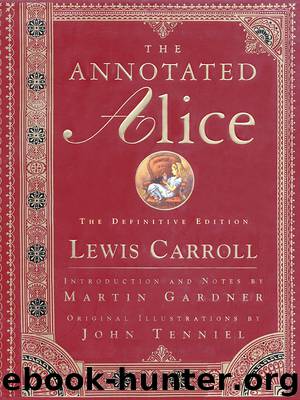The Annotated Alice by Lewis Carroll

Author:Lewis Carroll
Language: eng
Format: epub, mobi
Published: 2014-10-24T16:00:00+00:00
6. Alice’s speculation about looking-glass milk has a significance greater than Carroll suspected. It was not until several years after the publication of Through the Looking-Glass that stereochemistry found positive evidence that organic substances had an asymmetric arrangement of atoms. Isomers are substances that have molecules composed of exactly the same atoms, but with these atoms linked together in structures that are topologically quite different. Stereoisomers are isomers that are identical even in topological structure, but, owing to the asymmetric nature of this structure, they come in mirror-image pairs. Most substances that occur in living organisms are stereoisometric. Sugar is a common example; in right-handed form it is called dextrose, in left-handed form, levulose. Because the intake of food involves complicated chemical reactions between asymmetric food and asymmetric substances in the body, there often are marked differences in the taste, smell, and digestibility of left- and right-handed forms of the same organic substance. No laboratory or cow has yet produced reversed milk, but if the asymmetric structure of ordinary milk were to be reflected, it is a safe bet that this looking-glass milk would not be good to drink.
In this judgment on looking-glass milk only a reversal of the structure by which the milk’s atoms are linked to each other is considered. Of course a true mirror reflection of milk would also reverse the structure of the elementary particles themselves. In 1957 two Chinese-American physicists, Tsung Dao Lee and Chen Ning Yang, received the Nobel Prize for theoretical work that led to the “gay and wonderful discovery” (in Robert Oppenheimer’s happy phrase) that some elementary particles are asymmetric. It now appears likely that particles and their antiparticles (that is, identical particles with opposite charges) are, like stereoisomers, nothing more than mirror-image forms of the same structure. If this is true, then looking-glass milk would be composed of “anti-matter,” which would not even be drinkable by Alice; both milk and Alice would explode as soon as they came in contact. Of course an anti-Alice, on the other side of the looking-glass, would find anti-milk as tasty and nourishing as usual.
Readers who would like to learn more about the philosophical and scientific implications of left- and right-handedness are referred to Hermann Weyl’s delightful little book on Symmetry (1952) and Philip Morrison’s article “The Overthrow of Parity,” in Scientific American (April 1957). On the lighter side there is my discussion of left-right topics in the last chapter of The Scientific American Book of Mathematical Puzzles and Diversions (1959) and my story “Left or Right?” in Esquire (February 1951). The classic science-fiction tale involving left-right reversal is “The Plattner Story” by H. G. Wells. And one must not overlook The New Yorker’s Department of Amplification, December 15, 1956, page 164, in which Dr. Edward Teller comments with Carrollian wit on a previously published New Yorker poem (November 10, 1956, page 52) that describes the explosion that occurred when Dr. Teller shook hands with Dr. Edward Anti-Teller.
Recent nontechnical references on the symmetry and asymmetry of
Download
This site does not store any files on its server. We only index and link to content provided by other sites. Please contact the content providers to delete copyright contents if any and email us, we'll remove relevant links or contents immediately.
| Books & Reading | Comparative Literature |
| Criticism & Theory | Genres & Styles |
| Movements & Periods | Reference |
| Regional & Cultural | Women Authors |
4 3 2 1: A Novel by Paul Auster(12283)
The handmaid's tale by Margaret Atwood(7679)
Giovanni's Room by James Baldwin(7192)
Asking the Right Questions: A Guide to Critical Thinking by M. Neil Browne & Stuart M. Keeley(5635)
Big Magic: Creative Living Beyond Fear by Elizabeth Gilbert(5612)
Ego Is the Enemy by Ryan Holiday(5294)
The Body: A Guide for Occupants by Bill Bryson(4974)
On Writing A Memoir of the Craft by Stephen King(4863)
Ken Follett - World without end by Ken Follett(4645)
Adulting by Kelly Williams Brown(4487)
Bluets by Maggie Nelson(4473)
Eat That Frog! by Brian Tracy(4435)
Guilty Pleasures by Laurell K Hamilton(4360)
The Poetry of Pablo Neruda by Pablo Neruda(4039)
Alive: The Story of the Andes Survivors by Piers Paul Read(3968)
White Noise - A Novel by Don DeLillo(3954)
Fingerprints of the Gods by Graham Hancock(3942)
The Book of Joy by Dalai Lama(3899)
The Bookshop by Penelope Fitzgerald(3775)
